
Facebook Ads are the fastest and best way to reach qualified audiences to advertise your product and get conversions.
Whether you sell a physical product (ecommerce), digital product, B2B lead generation or most other business models, you can grow by using Facebook Ads.
I first began using Facebook Ads in 2007 when the platform launched.
A lot has changed since then. Sure it’s gotten more expensive but it’s also gotten much more effective.
Keep reading to craft your Facebook Ads game plan.
“Don’t use social media to impress people; use it to impact people.”
– Dave Willis, Author and Speaker
Social media is the most effective digital advertising channel, and with more than 2.7 billion active users globally Facebook particularly stands out as an essential tool for reaching customers.
It’s no secret, however, that Facebook’s ever-changing algorithm has made it difficult to connect organically with followers.
While Facebook’s algorithm changes de-prioritizing organic traffic has essentially forced businesses to invest in paid campaigns, Facebook has also built a platform that allows businesses to micro-target ads to reach the exact audience of people who are most likely to want your products or services.
Investing in Facebook is an essential way to connect with your audience, and 89% of marketers who use Facebook in their brand marketing efforts agree.
But just running ads isn’t a foolproof way to reach your targets—it takes planning and knowledge to reach digital advertising goals.
We’re diving into Facebook advertising and breaking down what you need to get started and the best practices on how to run Facebook ads.
How Facebook Ads Can Help Your Business

Most businesses are already aware of why it’s necessary to use Facebook ads and their huge benefit, especially when optimized well.
If you’re still not completely sold, here are a few of the perks that Facebook ads can provide your business.
Facebook Targeting is Extremely Powerful
Facebook’s targeting can be extremely granular—you can target based on interests, behaviors, demographics, age, connections, locations, languages, and even based on your competitors.
You can layer these targets to improve the quality of your audience and eliminate users who aren’t the ideal customer.
This means your ads are just shown to people who are most likely to convert.
You Can Remarket to People Who Already Interacted with You
If you’ve ever felt like you’ve been followed by an ad, it may feel annoying, but it’s extremely effective. This is the result of remarketing—or tagging people that have visited your website before to send them ads and remind them about your product or service.
The more people see your brand, the more likely they will take action.
You’ll Play on a Level Field
Compared to traditional marketing, Facebook advertising is pretty inexpensive which means it’s easy for all businesses to participate. It also means that companies of all sizes can compete on the same level.
They Can Raise Your SEO Rankings
Social signals are one of the things search engines look at to rank websites, so additional activity like shares, likes, and comments on your posts can increase your rankings.
You Have Clear Reporting to Understand ROI
In marketing, it can be tough to understand what your investment is getting you, especially with traditional marketing avenues like direct advertising, radio, or billboards.
Digital marketing is more sophisticated, but it can still sometimes be tough to determine exactly what kind of results your investment gained.
With Facebook advertising, the answers are clear—everything is measured from how many people saw your ad, how many clicked on it, and how many went further down the customer journey. You can see your cost per [whatever your ad objective is] quickly and easily to get a clear picture of your results.
Don’t Make These Mistakes When Running Facebook Ads
Whether you’ve experienced it already or not, there is a risk of spending quite a bit of money on Facebook ad campaigns with no results. It’s a real concern—a survey found that 62% of business owners say their paid ads on Facebook are missing the target.
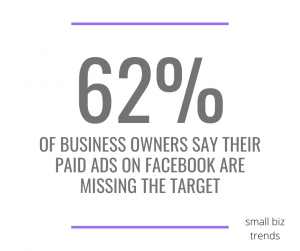
Here are a few ways of how ads can go wrong and have negative results.
Mistake #1: Just Hitting the “Boost Post” Button
While a traffic boost seems like a great thing for businesses, especially when Facebook tells you that you’ll be able to reach a few thousand more people, boosting your post is not the best way to do it.

Boosting a post restricts your ability to truly take advantage of Facebook’s audience targeting benefits. If this is how you’re currently advertising on Facebook, it’s time to set up your Facebook Business Manager and dive into a full-blown ad strategy.
Later in this article we show you exactly how to set up your Facebook Business Manager – keep reading.
Mistake #2: Setting Your Facebook Ads and Forgetting Them
While it’s easy and tempting to let your Facebook ads run on their own, the more attentive you are to your ads, the more productive they’ll be.
Ads that run too long without attention can run the risk of ad fatigue and may discourage customers.
When campaign frequencies get too high, the ad will receive less response and will lead to a higher cost per acquisition driving up your budget.
Mistake #3: Spending Money On Audiences that Have Already Converted
If you’re looking to attract new customers with your ads, you’ll want to make sure you’re excluding your current customers from your ads—otherwise, you might be spending money on the wrong people.
The easiest way to exclude your current customers is by using Facebook’s custom audience creation tool to upload a list and make an audience of them within Facebook, then excluding them from the ad.
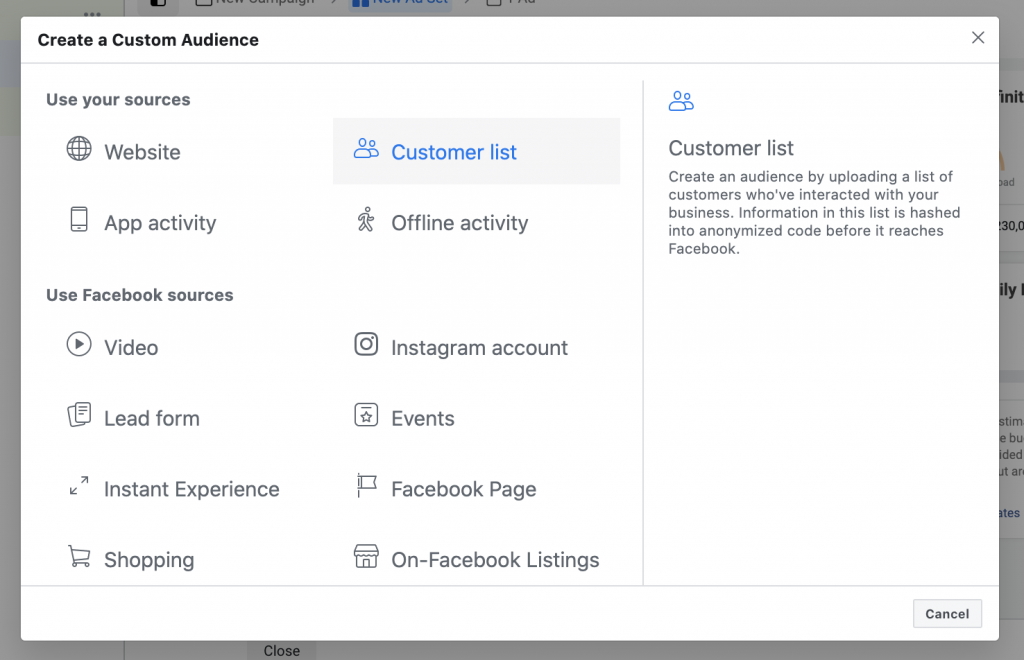
That way, you’re not wasting your money, and you’re not providing a poor customer experience by advertising to your current customers with ads asking them to be a customer.
Mistake #4: Lack of Strategy and Alignment with a Funnel
Anyone with a Facebook ad account can jump in and launch a campaign quickly… and sometimes it shows. One of the biggest mistakes businesses make is launching ads without looking at the big picture like strategy, objectives, and alignment with whatever funnel you want customers to take.
A very basic example: if you’re running a lead generation campaign, you might develop an audience that aligns to your target, set up an initial ad that offers them a lead magnet like an ebook or white paper, then you’ll want to retarget them with a second piece of content before a final ad that’s more of a sales pitch.
Mistake #5: Ads Aren’t Set Up Properly
Facebook ads are more than just an image and content, there are many options within Facebook for structuring the ads to meet your needs and objectives.
Because of this flexibility, it can make it complicated to structure your ad properly without letting things fall through the cracks.
Here are a few things to keep a close eye on when setting up your ads:
- Facebook Pixel: the pixel is a snippet of code that you add to your website to track the behavior and actions of your website visitors. You can use this data to learn about your visitors and target them based on the actions they take.
- Campaign Objectives: When you choose a campaign objective, Facebook analyzes its user data and serves your ads to people in your target audience who are most likely to take the action you want. That means, if you choose the wrong objective, you might not be speaking to the right people.
- Audience Targeting: This area is a little bit like Goldilocks—you might need to test some things out before getting to the right answer. You don’t want your audience to be too big or too small so your budget spends on pace.
- Ad Placement: Where you show your ad could be just as important as what the ad actually says. If you have mobile ads running but your mobile experience on your website isn’t great, you may be wasting precious budget on an experience that isn’t likely to convert.
Mistake #6: Not Testing
You would be surprised how little tweaks to your campaigns could make a big difference.
By testing small things against each other, you’ll learn to better understand the type of ad creative that attracts your ideal customer’s attention and use that knowledge in the future.
Stick to testing one thing at a time though—showing two completely different ads doesn’t give you much information on preferences.
The Different Types of Facebook Ads
There are two things that often get lumped together as “Facebook ad types”, and that’s ad objectives and ad formats. These are two very different things.
- Facebook ad objectives are the goal you want to reach from Facebook ads
- Facebook ad format is the creative format of your ad
Facebook Ad Objectives: Setting Goals for Your Ads

One thing every successful Facebook ad campaign has in common is that there were goals set in place to understand what success means.
One campaign might have gotten 2000 clicks, but if the goal was brand awareness and it had low impressions, it might not be considered a success.
To determine your Facebook ad goals, and therefore your objective, you’ll want to ask yourself what results you want from the campaign.
This could be to increase brand awareness, drive new leads, engage current customers, or get more sales.
Once you’ve defined the goal, you’ll want to track the right metrics that align with that goal within your ads manager.
Awareness
If you’re looking to get more attention for your company, this is the objective to choose. These ads should target the top of the sales funnel—let people know who you are and get your name in their minds.
There are two different awareness ads to choose from:
Brand Awareness: Encourages people to find your brand.
Reach: Shows your ad to the most people possible.
If your objective is awareness, you should track these metrics (KPI’s):
- Total impressions
- Cost per 1K impressions
- Reach
Consideration
If you’d like your advertising to focus on the middle of the funnel where people start thinking about your business and researching more information about it, you’ll want to advertise in the consideration stage.
This is a great stage to share content, including blog posts, how-to videos, and testimonials.
There are six types of consideration ads to choose from:
- Traffic: Sends traffic to your website for people to engage with content there.
- Engagement: Encourages people to engage with your Facebook page, including page likes, post engagements, responses to an event, or raise their hand to claim an offer you make.
- App Installs: Does what it says—gets people to install an app.
- Video Views: Generates video views.
- Lead Generation: Creates a lead form that people need to fill out right on Facebook.
- Messaging: Sends a message straight to a Facebook Messenger inbox.
If your objective is consideration, you should track these metrics:
- Clicks
- Click-through rate (CTR)
- Cost per click (CPC)
- Engagement rate
Conversion
The conversion objective encourages people to take an action, whether you want them to do something on your website, make a purchase, or offer their information.
These ads are “bottom-of-the-funnel”—all about the bottom line.
An important note is that to implement conversion ads properly, the Facebook pixel will need to be in place on the website.
There are three types of consideration ads to choose from:
- Conversions: Encourages actions on your website
- Product Catalog Sales: Tracks product sales
- Store Visits: Drives traffic to a store.
If your objective is conversion, you should track these metrics:
- Conversions (sales)
- Cost per conversion
- Conversion rate
- Click to conversion rate
If you are interested in learning more about the full marketing funnel we go into detail about it in our marketing playbook article.
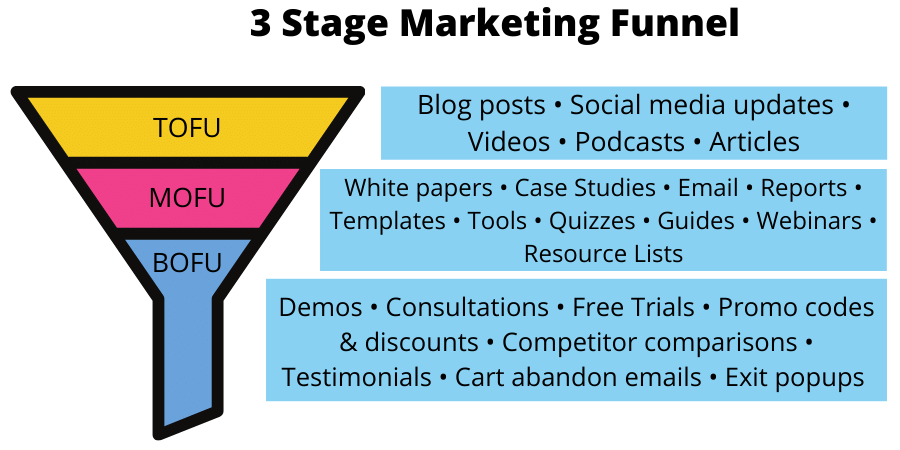
Facebook Ad Formats: Sharing Your Content the Way You Want
Different from the objective is the “ad format”, which defines the creative piece of the ad.
Depending on your objective, you may not be able to implement all the different ad formats.
The ad formats available are:
- Video Ads: this is an ad that includes a video. Facebook allows videos from other platforms like YouTube to be used in ads, but it prioritizes natively published videos, so it’s best to upload your video straight into Facebook for best results.
- Photo Ads: these are the most common and easiest ads to set up—it’s a single image with some kind of written content included. These often look like an organic Facebook post, but depending on placement, could have different formats.
- Slideshow Ads: this can either be a series of photos or a video, and you can make some edits like adding branding or music right within Facebook.
- Carousel Ads: this format includes multiple images and content in a scrolling format, and each post can include a separate link.
- Canvas Ads: only to be used in the brand awareness objective, canvas ads provide an immersive experience for the user.
- Dynamic Product Ads: similar to other dynamic ads, but specifically for featuring products.
- Lead Form Ads: users can fill a form directly on Facebook to gain a piece of content or raise their hands for more information from the company. These are good for B2B if you do not have your own landing page.
Facebook Ad Placements: Be Where You Need to Be
When setting up an ad on Facebook, you’ll see that your ad will usually automatically be set to “automatic ad placements”.
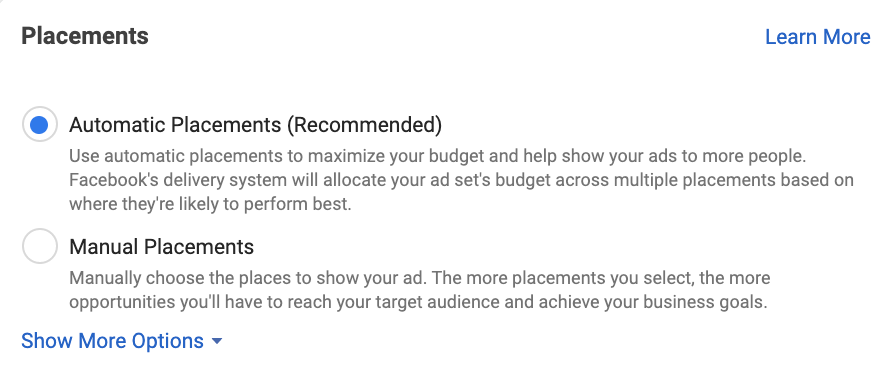
If you want to dive deeper into the different placements, you’ll find these options:
- Devices: Including mobile and desktop, and you can even break it down to specific devices.
- Facebook: Including the regular news feed, Facebook Marketplace, Facebook video feeds, the right column, Facebook Stories, in-stream, search results, and Facebook Instant Articles.
- Instagram: Including the Instagram feed, Instagram Explore, and Instagram Stories.
- Audience Network: Including ads in external apps, websites, videos, and in-stream videos within the Facebook network.
- Messenger: Including the messenger inbox, messenger stories, and sponsored messages.
It’s valuable to take the time to understand what each of these placements are and whether they are valuable for your business.
In general, Facebook will optimize if a certain placement isn’t working well, but if you know that your customers are on desktop only or don’t use Instagram, it’s smart to exclude those placements from the get-go.
PRO TIP: As a shortcut to get you started, you can begin with selecting devices (desktop, mobile or both), and Facebook and Instagram. Exclude Audience Network and Messenger when you start out. Add those placements later after you reach profitability with Facebook and Instagram.
Developing Audiences
There are three types of audiences \you can create on Facebook to define who you’d like to reach with your ads.
Creating an Audience
You can use Facebook’s targeting options to create an audience from scratch. You can use parameters such as:
- Location: targeting cities, countries, zip codes, even DMAs, and congressional districts. You can also define whether you want to target people who currently live in an area or just traveling.

- Demographics: You can look at age, gender, education level, and even relationship status to hone in on the people you’re trying to reach.
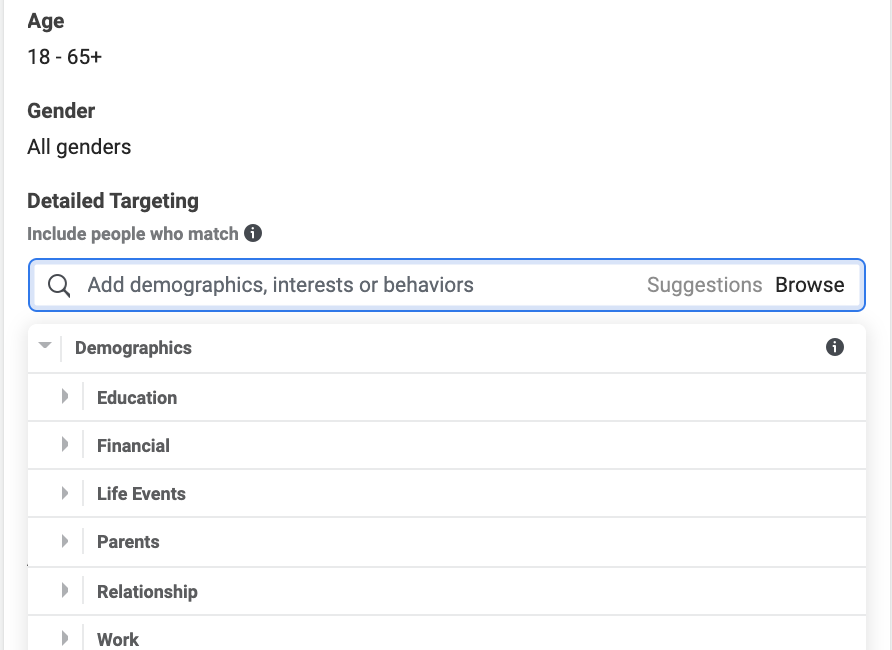
- Interests: Facebook’s data collection is vast, and their interest targeting is pretty sophisticated based on things people “like” and interact with on the network.

- Behaviors: Interestingly, Facebook also tracks information about people like if they’re ex-pats, device usage, and life events to be able to target people from that angle as well.
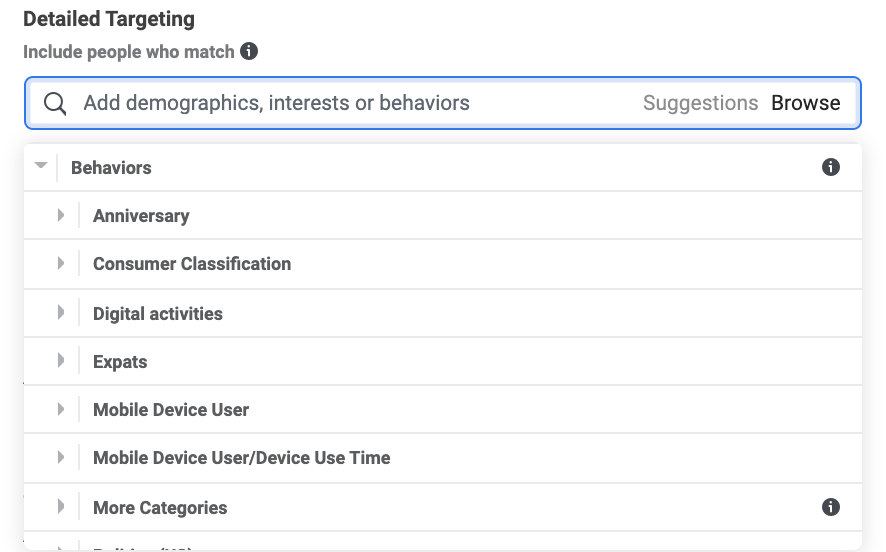
Custom Audiences
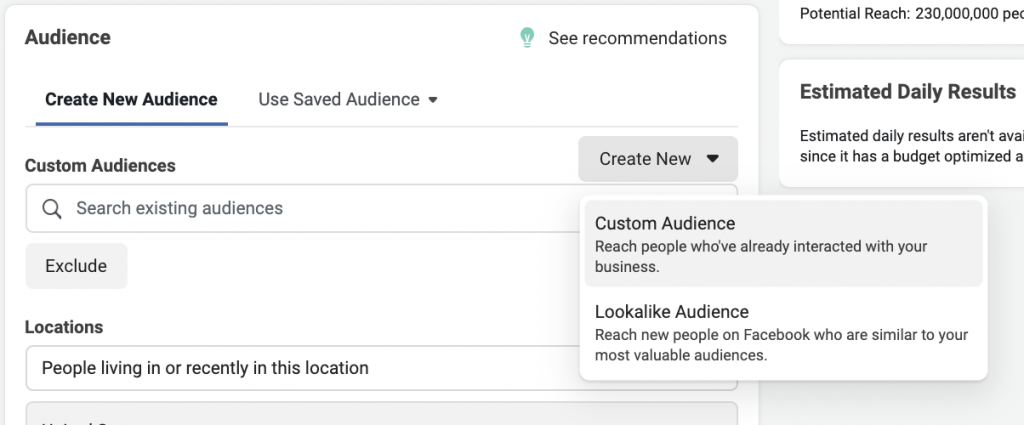
This type of audience is people who have already interacted with your brand.
You can create multiple types of custom audiences to re-market to, including people who interacted with your website or app, uploading a customer list, or from interactions within Facebook.
To implement these ads, the Facebook pixel will need to be installed. Keep reading to see how to install the Facebook pixel.

Lookalike Audiences
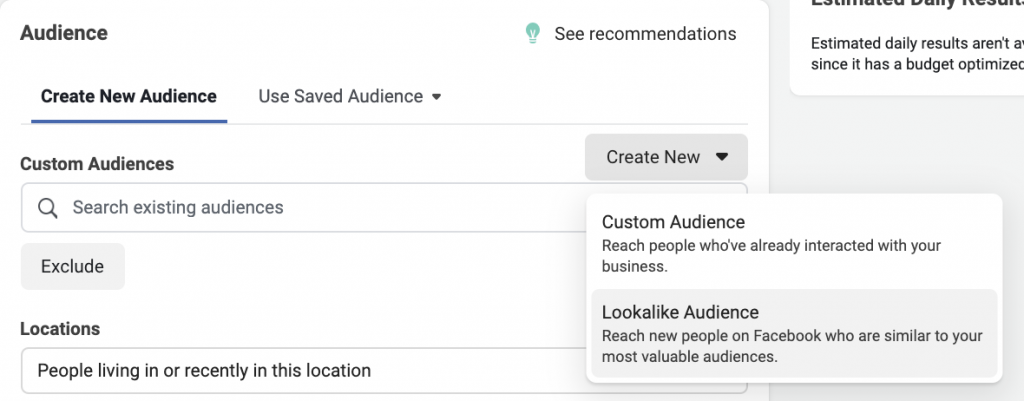
The final type of audience is lookalike audiences.
These audiences are built by the Facebook algorithm to essentially “look” like your current audience—these people will resemble people who have engaged with your brand, either as customers or through the Facebook page.
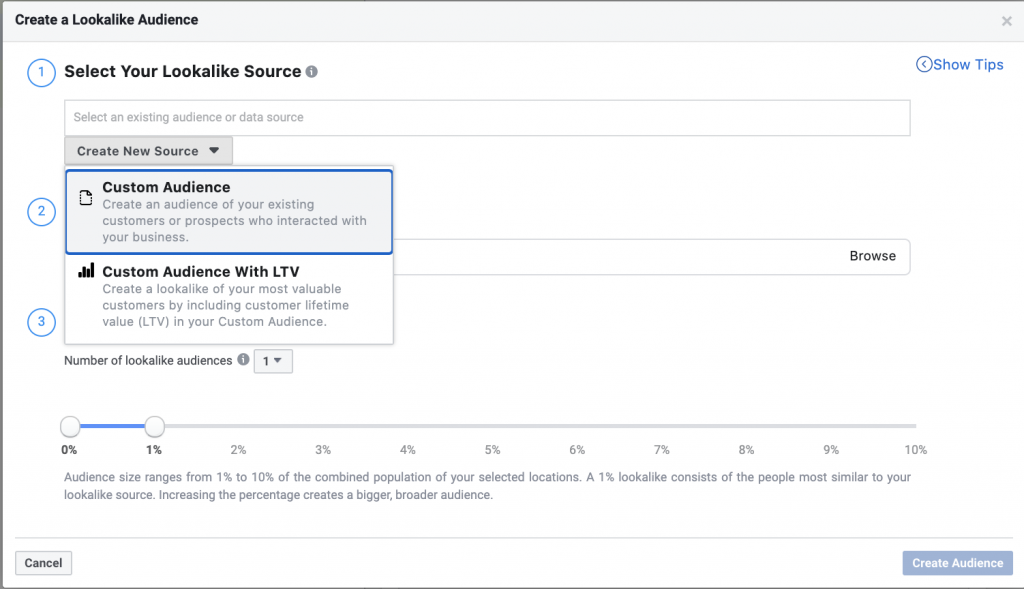
Excluding Audiences
There will be times where you will need to exclude certain people from your ads.
That may be because they’ve already made a purchase or taken the action that you wanted them to, or you may have another reason to not want them to see the ad.
You can do that while building the ad as well.
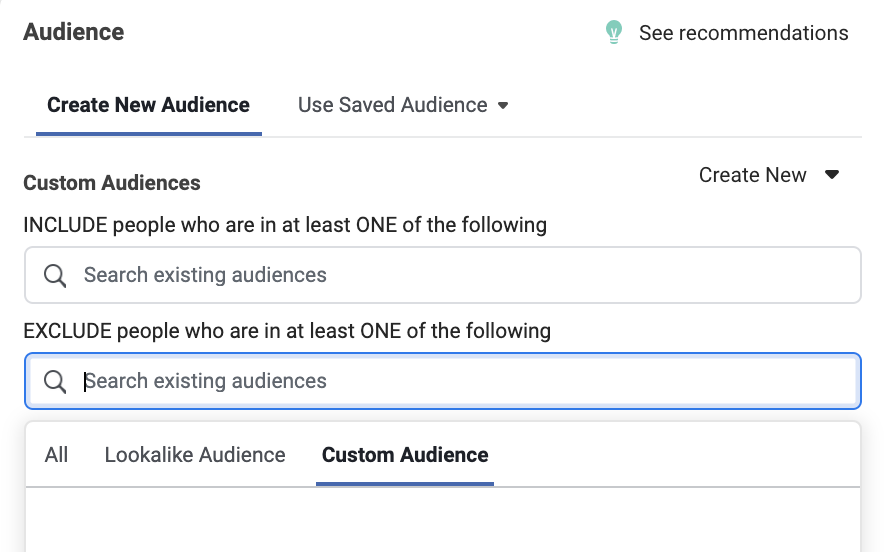
Getting Started
Setting Up Facebook Business Manager and Your Ad Account
Before getting started with your Facebook Ads Manager, you’ll need to make sure to have a Facebook Business Page.
To do that:
- Go to your Facebook profile and in the top right corner by your photo hit the + sign and choose “Page”.
- Follow the prompts to choose a name and category and enter your business information.
Once that’s completed, you’ll be able to access your ads manager. You can do that by:
- Going to https://www.facebook.com/business/tools/ads-manager
- Hitting the button “Go to Ads Manager”
- Confirming your information on the add account setup page
- Inputting your payment method + saving your changes
- Now you’re ready to create ads!
If you’ve already set up your ads manager in the past, you can access your manager in three ways:
- Use this link: https://www.facebook.com/adsmanager/manage/campaigns
- On your Facebook page, in the left sidebar, choose “Ads Manager”
- Download and use the Ads Manager app on your mobile phone

When you open ads manager, you should see this:
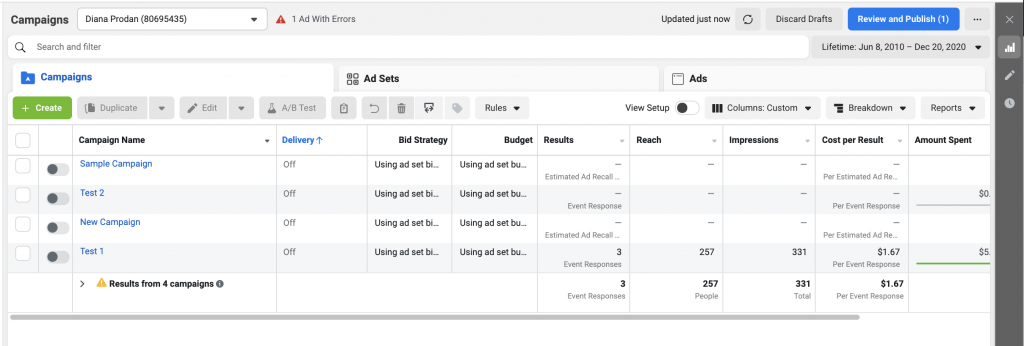
The green “Create” button will naturally be the area where you’ll get started creating a new campaign.
The Tech Side: Setting Up Your Pixel
To add a Facebook pixel to your website to accurately track and utilize your web traffic for ads, you’ll first need to create a pixel.
To do that, follow these steps:
- Go to https://www.facebook.com/events_manager
- Hit “Connect a Data Source” (if there isn’t one set up yet)
- Choose “Web”, then choose “Facebook Pixel”

4. Name your pixel, and then you’ll get to the Data Sources screen.
5. From there, you’ll want to highlight your newly created pixel and go to settings to get the information.

6. From here, you’ll head to your website, and use the pixel id number to install it within your code. Some website platforms like WordPress have spots to input the pixel, but if your site is custom you may need to code it in manually. If you are on Shopify, you’ll want to connect the Conversion API which you can do with 1-click conveniently within Shopify.
A Step-By-Step Guide to Creating Facebook Ads
Setup of the account is just the first step, now it’s time to start crafting Facebook ads that will encourage people to click.
And click they do—the average Facebook user clicks on 11 ads a month.
That makes it even more critical to set ads up right and get traffic moving to your website. Here are the steps for creating ads on Facebook effectively and efficiently.

Anatomy of a Facebook Ad
To get started, simply hit the green “Create” button in your ad account.
From there you’ll be prompted to walk through these steps:
- Campaign Objective: this is where you choose what your goals are for the campaign.
- Campaign Name: Name your campaign and if your ads fall into special categories you will need to notify of that.

3. A/B Testing: You can choose to A/B test your campaign at this point.
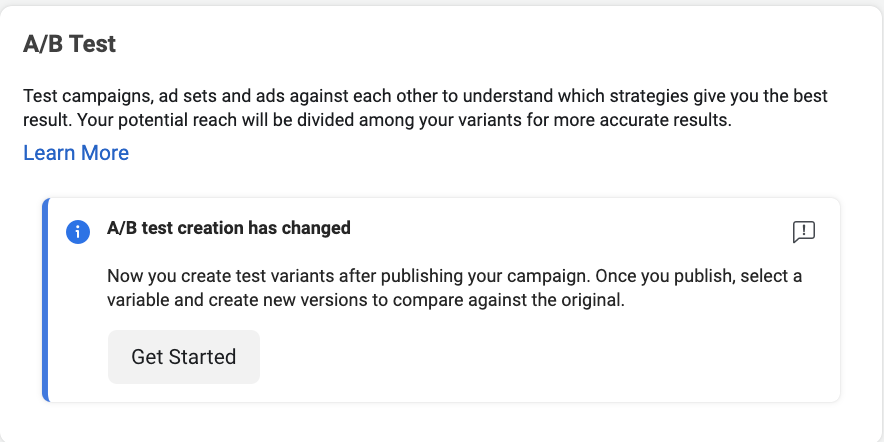
4. Budget Optimization: On this page, you can choose to do an A/B test, and how your campaign budget will be optimized. It can be optimized across the whole campaign or at the ad set level.
Facebook encourages campaign budget optimization, which is where a budget is set for the whole campaign, and the Facebook algorithm makes the decisions on which ad sets and ads receive budget.
We recommend doing the same by setting “campaign budget optimization”.
According to Facebook, campaign budget optimization can help if you want to:
- Set a campaign budget with flexibility in how that budget is spent across ad sets.
- Get the most results possible from your campaign, at the lowest cost.
- Simplify campaign setup and reduce the number of budgets you have to manage manually.
This is the recommended setting, especially starting out creating ads.
Ad Set Budget can be helpful when testing, but it does make things more complicated and requires quite a bit more oversight.

5. Campaign Budget: Set your campaign budget, either by lifetime or by day. If you hit “advanced options” you can also set when ads run—so if you’d prefer ads don’t run on weekends or you know certain times work better for your business, you can change that here.
6. Ad Set: At the ad set level is where we get into the details of the ad, including placements, audience, and how the campaign is optimized.
7. Dynamic Creative: Facebook’s answer to ad automation, this is where you provide multiple creative pieces like image and headline, and Facebook automatically generates combinations for your audience.
8. Audience Targeting: This is where you focus on reaching the right people—developing a strong target persona through Facebook’s in-depth audience network.
9. Ad Type: This defines the format of your ads—what they look like and how your audience consumes them.
10. Ad Placement: The details of Facebook ad placements often go overlooked—it allows you to hone in on the locations that your target audience would be most likely to find your ads. (Start with Facebook and Instagram while excluding Audience Network and Facebook Messenger.)
11. Creative: This is what’s front and center, the part that your target audience sees. It’s important to make sure the message is built for them and speaks to their needs.
Nitty Gritty Details: Ad Specs & Character Count

Here are the specs for the most common ads that run on Facebook.
(for in-depth information, check out Facebook’s Ad Guide)
Facebook Feed Ads
- Recommended image size: 1200 x 628 (1080 x 1080 for a 1:1 image).
- No maximum size restrictions
- Image ratio: 9:16 to 16:9 (no link involved), 1.9:1 to 1:1 (if there is a link)
- Image file types: .jpg or .png (Note: animated GIFS should be uploaded as a video ad)
- Text: 125 characters (if there is no link)
- Headline: 25 characters (any more will appear truncated)
- Link Description: 30 characters
- Images no more than 20% text
Facebook Video Ads
- Recommended uploading the highest-resolution source video available without letter or pillar boxing (no black bars).
- Minimum dimensions 600 x 315 (1.9:1 landscape) or 600 x 600 (square)
- Recommended aspect ratio is between 9:16 to 16:9 (Horizontal: 16:9, Square: 1:1, Vertical: 4:5 or 2:3 and Full Portrait: 9:16)
- Multiple acceptable video formats, but .MP4 or .MOV recommended
- Max video file size: 4GB
- Max video length: 240 minutes
- Video captions and sound: optional but recommended
- Video thumbnail image no more than 20% text
- Headline: 25 characters (any more will appear truncated)
- Link Description: 30 characters
Facebook Carousel Ads
- Image:
- Minimum image size: 600 x 600
- Recommended image size: At least 1080 x 1080. No maximum size restrictions
- Minimum 2 cards and max of 10 cards per Carousel Ad
- Recommended image ratio: 1:1
- Images no more than 20% text
- Image file types: .jpg or .png
- Text: 125 characters (if there is no link)
- Headline: 40 characters (any more will appear truncated)
- Link Description: 20 characters (optional on Instant Articles)
- Video:
- Recommended resolution (Facebook Carousel video): 1080 x 1080 pixels
- Minimum 2 cards and max of 10 cards per Carousel Ad
- proper aspect ratio: 1:1
- All video formats should be either .MP4 or .MOV
- Max video size: 4GB per video
- Max video length: 240 minutes
- Video thumbnail image no more than 20% text
- Text: 125 characters (if there is no link)
- Headline: 40 characters (any more will appear truncated)
- Link Description: 20 characters (optional on Instant Articles)
Facebook Right Column Ads
- Minimum image size: 600 x 600
- Recommended image size: 1200 x 628
- Image ratio: 9:16 to 16:9 (no link involved), 1.91:1 (if there is a link)
- Images no more than 20% text
- Image file types: .jpg or .png
- Text: 125 characters (if there is no link)
- Headline: 25 characters (any more will appear truncated)
- Link Description: 30 characters
In-Stream Video Ads
- Recommended to upload the highest-resolution source video possible
- Recommended aspect ratio is 16:9 (but can be between 9:16 to 16:9 (depending on the aspect of the main video)
- Multiple acceptable video formats, but .MP4 or .MOV recommended
- Max video file size: 4GB
- Max video length: 5 to 15 seconds
- Video captions and sound: optional but recommended (it makes sense to match these with the main video)
- Video thumbnail image no more than 20% text
Facebook Marketplace Ads
- Image:
- Minimum image size: 600 x 600
- Recommended image size: 1200 x 628
- Image ratio: 9:16 to 16:9 (no link involved), 1.91:1 (if there is a link)
- Images no more than 20% text
- Image file types: .jpg or .png
- Text: 125 characters (if there is no link)
- Headline: 25 characters (any more will appear truncated)
- Link Description: 30 characters
- Video
- Recommended to upload the highest-resolution source video possible
- Recommended aspect ratio is between 9:16 and 16:9
- Multiple acceptable video formats, but .MP4 or .MOV recommended
- Max video file size: 4GB
- Max video length: 240 minutes
- Video thumbnail image no more than 20% text
- Text: 125 characters (if there is no link)
- Headline: 25 characters (any more will appear truncated)
- Link Description: 30 characters
Facebook Instant Articles
- Image:
- Minimum image size: 600 x 600
- Recommended image size: 1200 x 628
- Image ratio: 9:16 to 16:9 (no link involved), 1.91:1 (if there is a link)
- Images no more than 20% text
- Image file types: .jpg or .png
- Headline: 25 characters (any more will appear truncated)
- Link Description: 30 characters
- Video:
- Recommended to upload the highest-resolution source video possible
- Recommended aspect ratio is between 9:16 and 16:9
- Multiple acceptable video formats, but .MP4 or .MOV recommended
- Max video file size: 4GB
- Max video length: 240 minutes
- Video thumbnail image no more than 20% text
- Headline: 25 characters (any more will appear truncated)
- Link Description: 30 characters
Facebook Stories
- Images
- Recommended image size: 1080 x 1920 (but keep your text within 1080 x 1420)
- Image ratio: 1.91 to 9:16
- Images no more than 20% text
- Image file types: .jpg or .png
- Video
- Recommended to upload the highest-resolution source video possible
- Recommended aspect ratio is between 1.91 to 9:16
- Leave 250 pixels at the top and bottom free from text and logos
- Multiple acceptable video formats, but .MP4 or .MOV recommended
- Max video file size: 4GB
- Max video length: 15 seconds
- Video thumbnail image no more than 20% text
Troubleshooting Under-performing Ads
You may have built an amazing, well-thought-out ad, and it still may not perform the way you want it to.
If your ads aren’t running up to par, We have a few troubleshooting tips to consider.
- Evaluate Your Bid: Of course, we all have budgets we need to stick to, but having a budget that’s not allocated correctly can have a huge effect on campaigns.
Tip: Raise your bid for just a day or two to see if you get better results. If you see a difference, re-evaluate your budget.
- Examine Your Ad Copy: Check your copy to make sure it’s written to convert, that it’s offering value, and that it has a clear incentive and call to action.
Tip: Before completely scrapping your old copy for new copy, A/B test the two against each other to see which performs better. In fact, it’s a good idea to always have small budget tests running to test creative, audiences, and the technical stuff.
- Tweak Your Audience Targeting: Your ad creative might be great, but it just might not be speaking to the right audience. It’s worth testing percentages of lookalike audiences or test out new behaviors and interests to see if they might be a more ideal audience. Start with a 1% lookalike audience before jumping to larger percentages.
Tip: When testing audiences, create a new ad set under a campaign optimized budget: it will allow Facebook to automatically adjust the budget toward the better performing ads.
- Keep an Eye on Frequency: If you’re seeing cost per result creeping up along with frequency, it might mean your audience has ad fatigue—they’re tired of the creative and need a new set or a break.
Tip: You don’t have to scrap old ads all together—have a few ads that you rotate out throughout your audiences so people aren’t seeing the same ad often.
What it All Means for Your Business
There’s no doubt that Facebook ads are a necessity for reaching audiences in this day and age: brands can reach approximately 2.14 billion users on Facebook through the ad system.
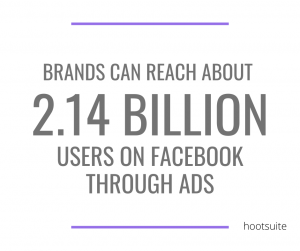
There are certainly many details that go into planning and implementing Facebook ads, but doing it right will be essential for growing your brand and reaching your goals.
Recent Comments